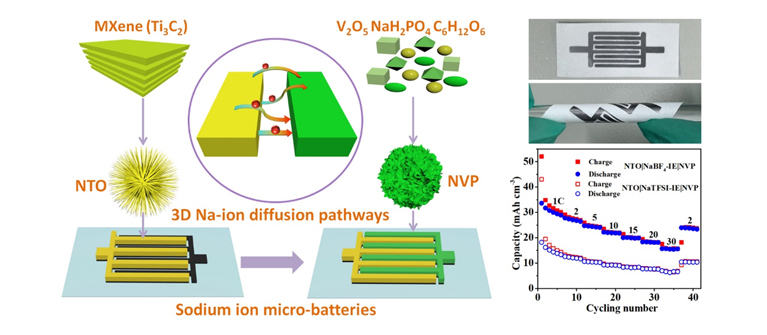A research team led by Prof. WU Zhongshuai and Prof. BAO Xinhe from the
Dalian Institute of Chemical Physics (DICP) of the Chinese Academy of Sciences, in collaboration with Prof. YU Yan from University of Science and Technology of China (USTC), developed high-performance ionogel-based sodium ion micro-batteries with 3D Na-ion diffusion mechanism.
The newly developed batteries, featured with ultrahigh rate capability, high areal energy density, remarkable mechanical flexibility and high-temperature stability, are promising in the development of microelectronics and microsystems.
Planar lithium ion micro-batteries (LIMBs) with interdigital microelectrodes can be seamlessly integrated into microelectronic devices mounted on a planar integrated circuit, facilitating the miniaturization of the entire microelectronic system. However, its development is limited by the scarcity, uneven distribution and increasing cost of metal lithium.
Since sodium is naturally abundant, low cost, and shows similarly low potential (-2.7 V vs SHE) as lithium, sodium ion micro-batteries (NIMBs) have been exploited after LIMBs. However, it faces challenges of lacking of effective electron-ion diffusion network and suitable electrolyte.

Schematic diagram of sodium ion micro-batteries. (Image by ZHENG Shuanghao)
To address this issue, the researchers reported one prototype quasi-solid-state planar ionogel-based NIMBs constructed by separator-free interdigital microelectrodes of sodium titanate anode and sodium vanadate phosphate cathode, both of which were embedded into three-dimensional interconnected graphene scaffold.
Meanwhile, a novel NaBF4-based ionogel electrolyte with robust ionic conductivity of 8.1 mS/cm was developed. The fabricated NIMBs revealed 3D multi-directional pathways for sodium ion diffusions, which can provide universal guidance to improve the performance of other planar micro-batteries.
Benefiting from the synergetic merits of the planar architecture, dominated pseudocapacitance contribution, and 3D multi-directional Na-ion diffusion mechanism, the assembled NIMBs exhibited high volumetric capacity of 30.7 mAh/cm3 at 1 C, and high rate performance with 15.7 mAh/cm3 at 30 C at room temperature and 13.5 mAh/cm3 at 100 C at high temperature of 100 oC.
Moreover, the quasi-solid-state NIMBs presented outstanding flexibility, tunable voltage and capacity output, and remarkable areal energy density of 145 μWh/cm2 (55.6 mWh/cm3).





